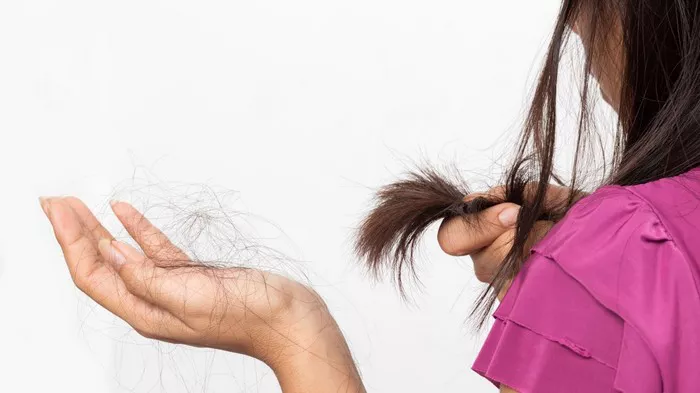Hair loss is a common concern for women of all ages, and it’s essential to understand what constitutes normal hair shedding. This article aims to provide comprehensive insights into the amount of hair loss that can be considered normal for females each day. We’ll explore the factors influencing hair loss, typical daily hair loss, and when it might be a cause for concern.
1. Understanding the Hair Growth Cycle:
To comprehend what is considered normal hair loss, it’s crucial to be familiar with the hair growth cycle. This cycle consists of three main phases:
a. Anagen (Growth Phase):
In this phase, hair actively grows and can last anywhere from 2 to 6 years. Approximately 85-90% of your hair is in this phase at any given time.
b. Catagen (Transitional Phase):
This is a short transitional phase lasting around 2-3 weeks, during which the hair follicle shrinks.
c. Telogen (Resting Phase):
Around 10-15% of your hair is in this phase, which lasts approximately 2-4 months. Hair in the telogen phase is shed to make way for new hair growth.
2. Factors Influencing Daily Hair Loss:
Several factors can influence the daily amount of hair loss, and it’s important to consider these variables:
a. Genetics:
Genetics play a significant role in determining the thickness and density of your hair. If your family has a history of hair loss, you may be more prone to shedding.
b. Hormonal Changes:
Hormonal fluctuations, such as those during pregnancy, postpartum, and menopause, can affect hair growth cycles and lead to temporary hair loss.
c. Age:
Hair loss tends to increase with age as the hair growth cycle may become shorter.
d. Stress:
High levels of stress can induce hair shedding. It’s essential to manage stress effectively to minimize its impact on hair loss.
3. Normal Daily Hair Loss for Females:
While it’s challenging to provide an exact number of hairs that can be considered normal to lose daily, most experts agree that losing between 50 to 100 hairs per day is within the normal range.
a. The 50-100 Hair Benchmark:
This benchmark represents the typical daily hair loss for females. It’s crucial to note that these hairs are often in the telogen phase, and their shedding makes way for new hair growth.
4. When to Be Concerned About Hair Loss:
Although some daily hair loss is normal, there are situations where you should be concerned about excessive shedding:
a. Sudden Increase in Hair Loss:
If you notice a sudden and significant increase in hair loss, it could be a sign of an underlying health issue and should be evaluated by a healthcare professional.
b. Noticeable Thinning or Bald Spots:
Thinning hair or the development of bald spots is a cause for concern and should be addressed promptly.
c. Scalp Conditions:
If you experience scalp conditions, such as redness, itching, or inflammation, and it’s accompanied by increased hair loss, seek medical advice.
5. Maintaining Healthy Hair:
While some hair loss is inevitable, there are steps you can take to promote hair health and minimize excessive shedding:
a. Balanced Diet:
A well-balanced diet rich in essential nutrients, such as iron, biotin, and vitamins, is crucial for maintaining healthy hair.
b. Gentle Hair Care:
Avoid harsh hair care practices, like excessive heat styling or tight hairstyles, which can contribute to hair damage and loss.
c. Stress Management:
Practicing stress-reduction techniques, such as meditation or yoga, can help mitigate hair loss caused by emotional stress.
d. Consult a Professional:
If you have concerns about your hair loss, it’s advisable to consult a healthcare professional or a dermatologist who can assess your specific situation and recommend appropriate treatments.
6. Potential Treatments for Hair Loss:
In cases where hair loss becomes a more significant issue, there are various treatment options available:
a. Topical Medications:
Topical medications like minoxidil can help stimulate hair growth and slow down hair loss.
b. Oral Medications:
Prescription medications, such as finasteride, may be recommended by a healthcare provider for certain types of hair loss.
c. Platelet-Rich Plasma (PRP) Therapy:
PRP therapy involves injecting platelet-rich plasma from your blood into the scalp to stimulate hair growth.
See Also: Hair loss due to PCOS: How to prevent it?
In conclusion
Understanding what constitutes normal hair loss for females per day is essential in addressing concerns about hair health. Daily hair loss can vary from person to person, but the benchmark of 50 to 100 hairs per day is generally accepted as normal. Factors such as genetics, hormones, age, and stress can influence daily shedding. If you notice a sudden and significant increase in hair loss or have other concerning symptoms, it’s crucial to consult a healthcare professional for a comprehensive evaluation and personalized treatment recommendations. By maintaining a healthy lifestyle and adopting suitable hair care practices, you can promote hair health and minimize the impact of excessive hair loss.


